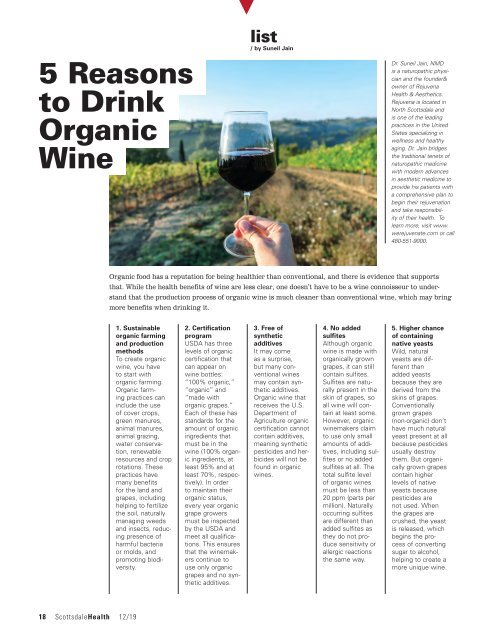Scottsdale Health December 2019
Create successful ePaper yourself
Turn your PDF publications into a flip-book with our unique Google optimized e-Paper software.
5 Reasons<br />
to Drink<br />
Organic<br />
Wine<br />
list<br />
/ by Suneil Jain<br />
Dr. Suneil Jain, NMD<br />
is a naturopathic physician<br />
and the founder&<br />
owner of Rejuvena<br />
<strong>Health</strong> & Aesthetics.<br />
Rejuvena is located in<br />
North <strong>Scottsdale</strong> and<br />
is one of the leading<br />
practices in the United<br />
States specializing in<br />
wellness and healthy<br />
aging. Dr. Jain bridges<br />
the traditional tenets of<br />
naturopathic medicine<br />
with modern advances<br />
in aesthetic medicine to<br />
provide his patients with<br />
a comprehensive plan to<br />
begin their rejuvenation<br />
and take responsibility<br />
of their health. To<br />
learn more, visit www.<br />
werejuvenate.com or call<br />
480-551-9000.<br />
Organic food has a reputation for being healthier than conventional, and there is evidence that supports<br />
that. While the health benefits of wine are less clear, one doesn’t have to be a wine connoisseur to understand<br />
that the production process of organic wine is much cleaner than conventional wine, which may bring<br />
more benefits when drinking it.<br />
1. Sustainable<br />
organic farming<br />
and production<br />
methods<br />
To create organic<br />
wine, you have<br />
to start with<br />
organic farming.<br />
Organic farming<br />
practices can<br />
include the use<br />
of cover crops,<br />
green manures,<br />
animal manures,<br />
animal grazing,<br />
water conservation,<br />
renewable<br />
resources and crop<br />
rotations. These<br />
practices have<br />
many benefits<br />
for the land and<br />
grapes, including<br />
helping to fertilize<br />
the soil, naturally<br />
managing weeds<br />
and insects, reducing<br />
presence of<br />
harmful bacteria<br />
or molds, and<br />
promoting biodiversity.<br />
2. Certification<br />
program<br />
USDA has three<br />
levels of organic<br />
certification that<br />
can appear on<br />
wine bottles:<br />
“100% organic,”<br />
“organic” and<br />
“made with<br />
organic grapes.”<br />
Each of these has<br />
standards for the<br />
amount of organic<br />
ingredients that<br />
must be in the<br />
wine (100% organic<br />
ingredients, at<br />
least 95% and at<br />
least 70%, respectively).<br />
In order<br />
to maintain their<br />
organic status,<br />
every year organic<br />
grape growers<br />
must be inspected<br />
by the USDA and<br />
meet all qualifications.<br />
This ensures<br />
that the winemakers<br />
continue to<br />
use only organic<br />
grapes and no synthetic<br />
additives.<br />
3. Free of<br />
synthetic<br />
additives<br />
It may come<br />
as a surprise,<br />
but many conventional<br />
wines<br />
may contain synthetic<br />
additives.<br />
Organic wine that<br />
receives the U.S.<br />
Department of<br />
Agriculture organic<br />
certification cannot<br />
contain additives,<br />
meaning synthetic<br />
pesticides and herbicides<br />
will not be<br />
found in organic<br />
wines.<br />
4. No added<br />
sulfites<br />
Although organic<br />
wine is made with<br />
organically grown<br />
grapes, it can still<br />
contain sulfites.<br />
Sulfites are naturally<br />
present in the<br />
skin of grapes, so<br />
all wine will contain<br />
at least some.<br />
However, organic<br />
winemakers claim<br />
to use only small<br />
amounts of additives,<br />
including sulfites<br />
or no added<br />
sulfites at all. The<br />
total sulfite level<br />
of organic wines<br />
must be less than<br />
20 ppm (parts per<br />
million). Naturally<br />
occurring sulfites<br />
are different than<br />
added sulfites as<br />
they do not produce<br />
sensitivity or<br />
allergic reactions<br />
the same way.<br />
5. Higher chance<br />
of containing<br />
native yeasts<br />
Wild, natural<br />
yeasts are different<br />
than<br />
added yeasts<br />
because they are<br />
derived from the<br />
skins of grapes.<br />
Conventionally<br />
grown grapes<br />
(non-organic) don’t<br />
have much natural<br />
yeast present at all<br />
because pesticides<br />
usually destroy<br />
them. But organically<br />
grown grapes<br />
contain higher<br />
levels of native<br />
yeasts because<br />
pesticides are<br />
not used. When<br />
the grapes are<br />
crushed, the yeast<br />
is released, which<br />
begins the process<br />
of converting<br />
sugar to alcohol,<br />
helping to create a<br />
more unique wine.<br />
18 <strong>Scottsdale</strong><strong>Health</strong> 12/19

















